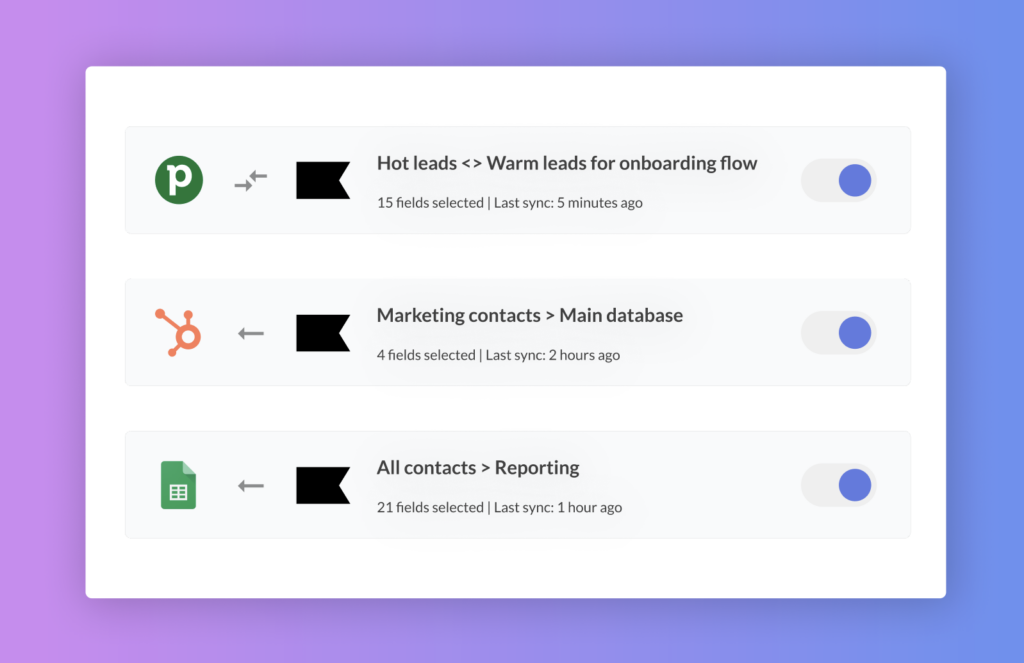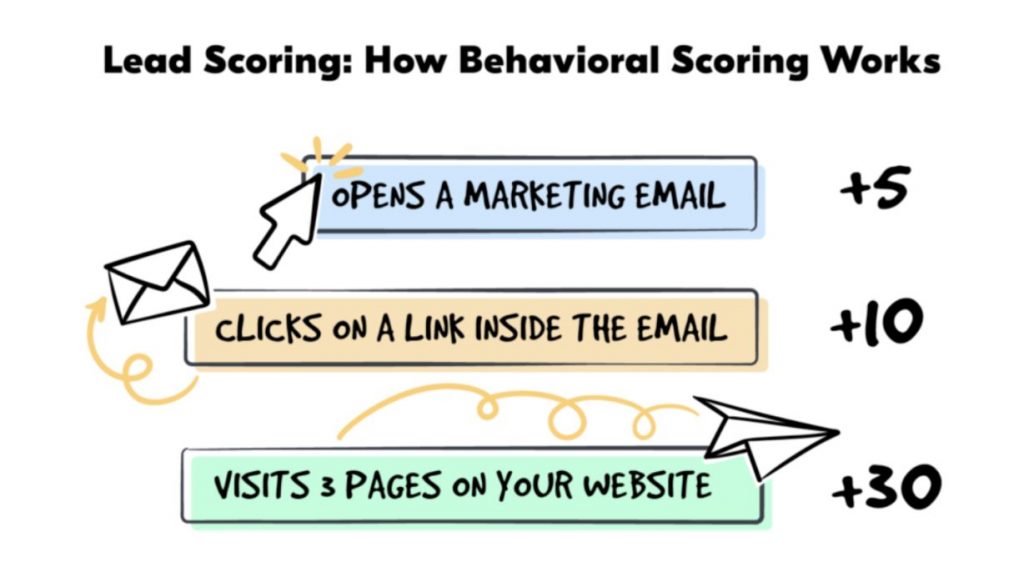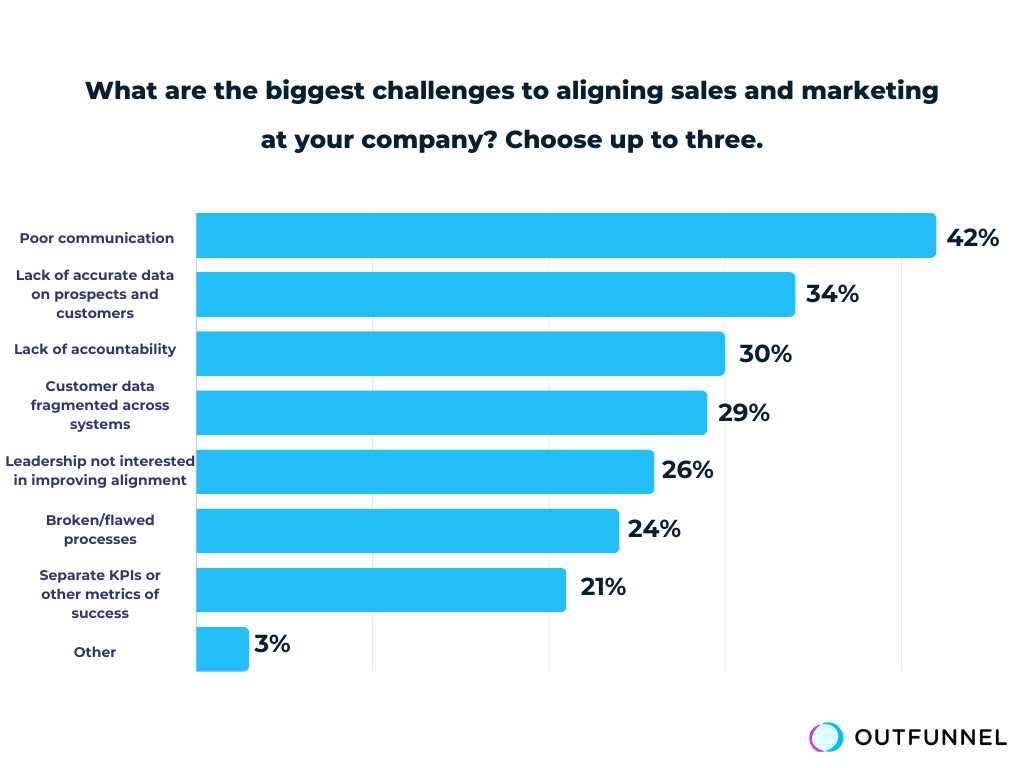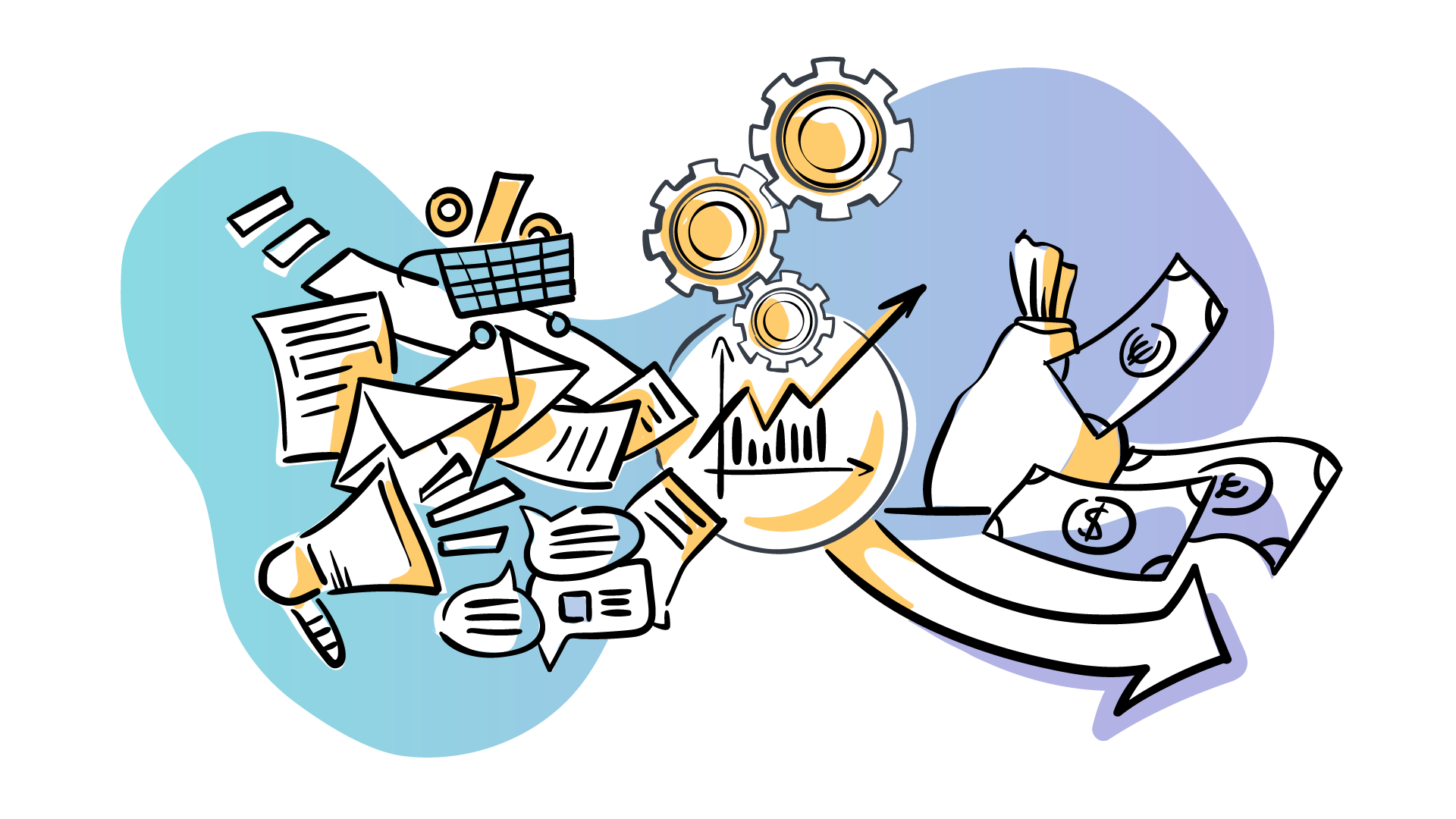Last updated: Aug 2025
Facing the pressure to ramp up revenues without expanding your team?
Trust us, you’re far from alone. According to a recent State of Sales survey by Salesforce, a staggering 85% of sales leaders are in the same boat.
This guide is your one-stop resource for understanding and activating sales productivity for hitting those numbers.
By reading on, you will unlock the what, the why, and the how of sales productivity, all while getting actionable insights to “do more with less.”
No sugar coating here, just straight-up, practical wisdom to transform your sales operations.
Stick with us; this is the playbook you’ve been searching for.
What is sales productivity? A guiding definition for all
When it comes to sales productivity, you’ll hear a lot of definitions flying around, each cloaked in its layer of corporate jargon. But let’s cut to the chase, shall we?
Wyndham Hudson, VP of Product at Copper, sums it up pretty well:
So, if you’re still asking, “What is sales productivity?” consider this: It’s the secret sauce, the X-factor that transforms a ‘good enough’ sales team into a powerhouse, a juggernaut of efficiency and effectiveness combined.
💡 Pro tip: These days, maximizing productivity isn’t just about hustle – it’s also about smarts. Many teams are now turning to AI-powered tools to streamline repetitive tasks, surface the best leads, and write more compelling emails. When used right, AI becomes a “tailwind” for your team, helping you to accomplish more of what matters – faster.
5 compelling reasons to give sales productivity the attention it deserves
So, we’ve warmed you up on sales productivity, giving you a sneak peek into its transformative power. Now, let’s get into the nitty-gritty of why it deserves your full attention.
#Reason 1: Do more with the same team
Maximizing the productivity of your existing team is like finding money in the couch cushions, but way more impactful. You get the revenue gains of a larger team without stretching your resources thin. In short, you keep the team agile and high-performing, making every sales rep a linchpin of efficiency and effectiveness.
Remember, the aim is not to exhaust your team but to channel their efforts in the most lucrative directions – more deals and more revenue, all with the same number of people.
#Reason 2: Improved work-life balance for every rep
Sales reps often find themselves in a never-ending hustle, juggling client meetings, endless calls, and late-night follow-ups. The result? Burnout, high turnover, and a dip in performance. You might even notice that your team starts missing targets or, worse, losing their passion for what they do.
When you fine-tune sales productivity, it’s akin to giving your team the gift of time. Time to live, time to breathe, and yes, time to sell, but without the constant grind. This harmony leads to happier reps, and let’s face it, a happy sales rep is a productive one. A balanced life makes room for creativity, strategy, and those little nuances that transform a good salesperson into a great one.
#Reason 3: Predictable revenue and easier forecasting
Every sales leader has faced the frustrating challenge of predicting future revenue numbers, especially when team productivity fluctuates like a roller coaster. You’re not a fortune teller, but everyone acts like you should be. Miss the mark, and you’ll hear about it – maybe in the next all-hands meeting.
With a productive team, the variables are reduced. You know how long it takes, on average, to move a lead through the funnel. You have a good idea of conversion rates at each stage. You’re aware of seasonal trends that impact your sales. All these elements turn into data points that feed into your forecasting models. Now, you’re not just hoping to hit those quarterly targets; you’re expecting to.#Reason 4: Streamlined onboarding and faster ramp-up
Traditionally, it takes months for a new sales rep to get up to speed and close deals. During this period, they’re often more of a resource drain than an asset. It’s like you’re on a flight, but half the engines aren’t yet on.
When you’ve got a culture and infrastructure that prioritize sales productivity, this scenario changes dramatically. Suddenly, the runway to ramp up shortens. Your newbies aren’t just shadowing the pros or aimlessly clicking through a learning management system; they’re quickly becoming productive contributors. It’s the kind of cycle that turns your sales operation into a self-reinforcing growth machine. And who doesn’t want that?
#Reason 5: Enhanced customer experience and retention
When your team is productivity-focused, they have the time to nurture relationships instead of just chasing the next quick win. They follow up, check in, and make sure customers are getting value long after the contract is signed. Happy customers become long-term contracts and recurring revenue streams.
So, by zeroing in on productivity, you’re effectively turning every sales rep into a customer relations pro.How to measure sales productivity? Understanding the key metrics
Measuring sales productivity is not just a numbers game; it’s a balancing act.
While quantitative metrics help you track and meet targets, qualitative measures offer insights into the skills and behaviors that numbers can’t capture. Over-focusing on just the hard stats could blind you to other vital aspects of your sales process.
So, we’ll guide you through both the quantitative and qualitative angles to give you the full picture.
Key quantitative metrics for sales productivity
Quantitative metrics are numerical measurements used to evaluate and quantify specific aspects of your sales performance. These metrics are typically measured using objective criteria and are crucial for tracking and improving sales operations. Let us look at some of the most popular ones below:
Time spent on actual selling
- What it measures: Time spent on actual selling measures the proportion of a sales rep’s workday dedicated to revenue-generating activities – think prospecting, nurturing leads, making calls, and conducting demos – versus time-draining admin tasks like data entry, report generation, and scheduling meetings.
- How to measure: Start by breaking down your day or week into selling and admin tasks. Use a time-tracking tool to identify where your hours are going. Calculate the percentage of time spent on selling activities by dividing the hours spent on revenue-generating tasks by the total work hours, then multiplying by 100. For instance, if you spend 30 out of your 40-hour workweek on sales activities, that’s a 75% focus on actual selling, leaving you with a 25% admin burden.
Close rate
- What it measures: Close rate is the percentage of deals that go from a proposal or quote stage to a signed contract. It gives you an idea of how effective your sales team is at sealing the deal once they have a foot in the door.
- How to measure: Count the number of deals that moved from proposal to closed-won status in a specific time period. Divide that by the total number of proposals sent out during the same period and multiply by 100 to get the percentage.
Lead response time
- What it measures: Tracks how quickly your sales reps engage with a new lead after they enter your system.
- How to measure: Measure the time from when a lead is captured (e.g., form submission, inbound call, etc.) to the first meaningful contact made by a sales rep. This is typically recorded in minutes or hours.
Upsell and cross-sell rates
- What it measures: This metric helps you understand how good you are at selling more to existing customers. Are you just a one-hit-wonder, or do you have the skills to keep the cash register ringing?
- How to measure: Calculate the number of deals where you’ve managed to upsell or cross-sell and divide it by the total number of customer interactions. Multiply by 100 to get a percentage rate. So, if you upsell on 20 out of 100 interactions, your rate would be 20%.
Sales cycle length
- What it measures: The average time it takes to move a lead from the initial contact to closing the deal. It helps you understand how efficient your sales process is and how quickly you can turn prospects into customers.
- How to measure: Track the time it takes for each deal to progress from the first interaction to closing. Then, calculate the average time across all deals. The shorter the sales cycle, the more efficiently you’re converting leads into revenue.
Revenue per sales rep
- What it measures: A direct measure of how much money each salesperson is bringing in. It tells you how effective and productive individual sales reps are in generating revenue.
- How to measure: Take your total revenue and divide it by the number of sales reps on your team. The result is the average revenue generated by each salesperson.
Proposals sent
- What it measures: This metric shows the volume of proposals you’re sending out to prospective clients. A higher rate indicates a busier pipeline, but it also sets the stage for you to analyze your close rate later on.
- How to measure: Count the proposals sent over a specific time, like a month. Then, see how many of those turned into closed deals to understand how well you’re converting leads.
Demos given
- What it measures: The number of demos your team gives. This is a key activity in the sales process, often happening right before a deal closes. More demos could mean more chances to close deals, making it a strong indicator of a sales rep’s productivity.
- How to measure: Keep track of how many demos you do in a certain time frame, like a month. Compare this to the number of deals that close afterward. If a lot of demos lead to closed deals, your sales reps are likely highly productive in this area.
Outbound calls made
- What it measures: If outbound marketing is a major part of your sales process, then the number of outbound calls your reps make becomes a key indicator of their productivity. More than just a tally, this metric serves as a barometer for your team’s proactive engagement with potential clients.
- How to measure: Track the total number of outbound calls made by each sales rep over a given time frame – weekly, monthly, or quarterly. Don’t just stop at the count; evaluate these numbers against your conversion rates to see how effective these calls are in generating leads or closing deals.
Email conversations triggered
- What it measures: This metric shows how many replies you get from the cold emails your team sends. A high reply rate means your reps are doing a good job with their email outreach strategy.
- How to measure: Track the number of replies received from the total cold emails sent by your sales reps over a set period. To make this even more insightful, measure the quality of those replies – are they leading to scheduled meetings, further conversations, or even sales?
Key qualitative measures for sales productivity
Qualitative measures delve into the less tangible but equally crucial aspects of your sales performance. They go beyond the numbers and offer insights into skills, behaviors, and customer interactions. Here, we’ll explore some helpful qualitative measures that shed light on your sales team’s effectiveness and customer relations:
Relationship-building skills
- What it measures: The ability of your sales team to cultivate strong, lasting relationships with clients and prospects, which can lead to trust, loyalty, and repeat business.
- How to measure: Gather feedback from clients and prospects about their experiences working with your sales team. Inquire about the quality of interactions, their perception of trust and rapport, and whether they feel their needs were genuinely understood.
Team collaboration
- What it measures: How effectively your sales team collaborates with other departments, such as marketing or customer support, to streamline processes, share insights, and ultimately enhance the customer experience.
- How to measure: Assess the frequency and quality of communication between different departments.
Adaptability
- What it measures: Can your sales team change gears fast? This is about handling surprises and challenges well.
- How to measure: After meetings, ask your team how they managed any curveballs. Did they adjust well or fumble?
Tech savviness
- What it measures: How proficient your sales team is at using digital tools to make their lives easier and their work more efficient. This is 2023, folks, and the right tech can make or break your sales game.
- How to measure: You can check a few things. First, are they using all the CRM features to manage leads and client info? Second, when new tools roll out, how quickly do they get the hang of it? Lastly, are tech errors going down over time?
Now, you’ve got the numbers, you’ve got the soft skills, but how do you put all this newfound wisdom to work? Stick around as we dive into key strategies to turn these insights into a killer playbook for boosting your sales productivity.
| Metric | What it Measures | How to Track |
|---|---|---|
| Time Spent Selling | % of time on sales tasks vs admin | Time-tracking software or manual task logs |
| Close Rate | Deals won / Proposals sent | CRM deal tracking |
| Lead Response Time | Time from lead capture to first contact | CRM timestamps, automation logs |
| Revenue per Rep | Revenue divided by number of reps | Sales reports |
| AI-Boosted Lead Scoring | Quality of lead prioritization using AI | Engagement-based scoring inside your CRM |
9 actionable strategies to boost sales productivity? Your upgraded playbook
We’ve done the homework, so you don’t have to. These nine strategies are actionable and versatile enough for any sales team.
You might be using some of these strategies already, but we promise you’ll learn to optimize them even further. Plus, we’ve sprinkled in a few game-changers you probably haven’t considered. Think of this as your upgraded, all-in-one playbook for skyrocketing sales productivity.
#1 Create a productivity measurement plan
We’ve talked a lot about measuring sales productivity, and here’s the deal – you’ve got to have a rock-solid measurement plan in place.
Why? Because if you’re not measuring, you’re just messing around. Having a measurement plan shows you if things are going well or if you need to make some changes. It’s like a roadmap for your sales efforts.
Here are some elements to include in your sales productivity measurement plan:
- What you will measure: Choose the KPIs that actually mean something to your sales process. It could be call-to-close ratios, lead response time; you name it.
- How you will measure: Pick the right tools to gather the data. If you’re using Outfunnel, for example, it’ll play nicely with your CRM and even automate some of this for you.
- When you will measure: This ain’t a one-and-done thing. Set regular intervals for data collection – daily, weekly, monthly or whatever makes sense for your team.
- Who will measure: Assign someone responsible for tracking these metrics. Accountability is key here, folks.
Great, now there’s no excuse for not knowing whether you’re crushing it or need to step it up a notch.
#2 Leverage technology, AI and automate tasks
If you’re still stuck doing everything manually, you’re basically competing in a Formula 1 race on a tricycle. Why? Because technology can be your turbo boost in the world of sales productivity.
Why do software and automation matter?
- Do more with less: The best sales teams are armed to the teeth with tools that make their lives easier. They automate tasks so they can focus on what really matters – building relationships and closing deals.
- Say goodbye to human error: Let’s face it; we’re all human and make mistakes. But when you automate repetitive tasks, you minimize the risk of those ‘oops’ moments that could cost you a deal.
- All your data in one place: With a good tech stack, you can integrate multiple tools to have a unified view of your customer data inside your most used software – the CRM. Think of it as your mission control for sales.
Ready for some practical examples that will make you an automation believer? Here we go!
Example 1: Marketing data syncing seamlessly with your CRM
If your sales reps use Copper as a CRM and your marketing team is running nurturing campaigns via a marketing automation platform, how do you make sure your reps have the full story? What if a rep is about to call a lead who recently signed up to attend a webinar from a marketing ad on LinkedIn?

Here’s why it’s a game-changer:
- 2-way data sync: Keeps your sales and marketing data in sync both ways, so everyone’s on the same page.
- Setup without hassle: No need for coding skills or expensive consultants. It’s plug-and-play, saving you time and money.
Example 2: Prioritize leads with intelligent lead scoring
Back in the day, you’d waste hours, maybe even days, trying to figure out which leads were worth your golden touch.
Now, with smart lead scoring, you know who’s ready to buy and who needs more time. It’s like having a cheat sheet for a test.
Outfunnel helps you do this really easily. It connects with your CRM and marketing tools and lets you pick the best leads based on real stuff, like who’s visiting your site or opening your emails. Basically, Outfunnel picks all the engagement signals, computes the lead scores and makes them accessible via your CRM.
Beyond basic engagement metrics, some AI tools can predict which leads are most likely to convert based on historical data. Think of it as lead scoring on steroids – with machine learning analyzing patterns that would take humans forever to spot.
Pair this with Outfunnel’s lead scoring setup and you’ve got a system that not only tracks behavior but also learns and improves over time.

Example 3: Turn your customer conversations into insights faster
Reviewing an hour-long prospect call for a 30-second bit of wisdom? Ain’t nobody got time for that. Enter conversation intelligence software like Gong and Otter. These tools transcribe and analyze your calls, offering actionable insights for your next conversation. So, you get to ditch the post-call note-taking and focus on what you do best – selling.
For the full scoop on sales automation, don’t miss our dedicated blogs: Sales Automation Explained: 11 Must-Try Automation Ideas and 20 Top Sales Automation Tools To Do More With Less.
Example 4: Use AI tools to generate and personalize outreach
Writing emails, follow-ups, or even call scripts can be time-consuming, especially when reps are juggling dozens of leads. AI writing tools like ChatGPT or Lavender help craft personalized emails at scale – saving reps hours each week while improving open and reply rates.
And guess what? Some tools even integrate directly with CRMs, letting you generate content based on the exact lead info in your database.
| Use Case | AI Tool | How It Helps |
|---|---|---|
| Writing personalized emails | ChatGPT, Lavender | Drafts tailored outreach faster |
| Scheduling meetings | Reclaim, x.ai | Automates back-and-forth calendar invites |
| Call transcription & coaching | Gong, Otter, Fireflies | Surfaces insights and coaching tips |
| Lead prioritization | Outfunnel, MadKudu | AI-driven scoring based on engagement |
| Sales enablement content | ChatGPT, Copy.ai | Quick scripts, templates, follow-ups |
A note on automating everything:
Before you automate, master your process manually. Case in point: when we automated our user onboarding at Outfunnel, we’d already walked through the process, engaged with leads, and tackled obstacles. Automation is a tool, not a crutch. Remember that.
#3 Optimize and document sales processes with playbooks
Imagine if every new team member could leap into action without stumbling through the basics. That’s what a playbook offers – accelerated onboarding, fewer mistakes, and a more cohesive team approach. Having a playbook for key sales processes is like having cheat codes in a video game. You skip the grind and get straight to leveling up.
Not just that, if you’re optimizing with tech – say, using Outfunnel for automated lead entries and scoring- highlight that in the playbook, too. You’d want your team to take full advantage of that turbo boost, wouldn’t you?
Facing resistance to change? You’re not alone. Paul Willerton, over at DeFeet International, got some serious side-eye when he introduced Copper CRM in his organization. But when one of their lead sales reps had to take a health timeout, that CRM became their saving grace.
Paul’s advice?
“Be prepared to adapt and make those hard decisions, and have the commitment in the moves you make. It’s imperative to survive… When you see the writing on the wall, don’t put off the decision.”
#4 Invest in continuous learning
In a rapidly evolving market, yesterday’s strategies are tomorrow’s ancient history. Continuous learning helps you adapt and thrive, not just survive. Plus, a better-informed sales rep can engage customers with more depth and context – so you’re not just selling a product, you’re offering solutions.
Some tips for implementing this practice:
- Weekly team training: Make it a ritual. Discuss one new strategy or tool every week.
- AI coaching tools: Platforms like Gong, Chorus, and Fireflies don’t just transcribe calls — they now offer AI-driven feedback on talk-to-listen ratio, objection handling, and sales script adherence. Use these insights for personalized coaching that actually moves the needle.
- Online courses: There are a plethora of courses out there. Pick ones that are actionable and directly beneficial to your role.
- Reading: Articles, e-books, and even Twitter threads from sales gurus can offer bite-sized insights that are easy to implement.
- Peer-to-peer learning: Sometimes, the best wisdom comes from the cubicle next door. Create an internal forum or even a Slack channel dedicated to sharing sales tips and insights.
Think of continuous learning as your gym membership to the Sales Hall of Fame. Forget just hitting quotas – you’ll be the one setting them.
#5 Establish alignment between sales and marketing

When sales and marketing are in sync, everything runs smoother. Sales reps get high-quality leads to focus on, making their work both easier and more effective. Plus, they get solid insights from marketing that help them close deals faster.
But here’s the rub – when these two aren’t aligned, productivity drops drastically. For example, imagine sales using one list of contacts and marketing using another, and the two databases not synced together. What happens? Mixed-up campaigns, confused customers, and sales reps wasting time doing data detective work instead of racking those juicy commissions.
Here are some tips to harmonize sales and marketing relationships:
- Regular check-ins: Schedule periodic meetings between sales and marketing to discuss wins, losses, and opportunities.
- Shared KPIs: Unified metrics ensure everyone is aiming for the same goals, be it lead quality or customer lifetime value.
- Centralized data hub: Use tools like Outfunnel to integrate sales and marketing data. This way, everyone has access to the same, up-to-date information.
- Feedback loops: Implement a formal process for sales to provide feedback to marketing about lead quality and for marketing to give insights into campaign effectiveness to sales.
- AI-generated insights: Some tools can now analyze interactions across email, call transcripts, and deal stages to surface insights your team might miss. This can help marketing craft better messaging and enable sales to time their outreach more effectively.
And there you have it- a blueprint for a harmonious sales and marketing alliance that’s more Batman and Robin, less Tom and Jerry.
#6 Reward productivity best practices
Look, we all love the thrill of the chase and the high fives that come with closing a big deal. But let’s not forget about the hustle that leads up to it.
Whether it’s acing a cold call or perfectly qualifying a lead, you would want to cultivate a sales culture that values the process.
Because, let’s be real, being deal-obsessed isn’t bad, but a well-oiled process makes those deals even sweeter.
For example, if a team member consistently exceeds their ‘meetings booked’ target, you can organize a team showcase meeting to spotlight their achievement. Let them break down their approach. What tactics worked? What didn’t? Encourage discussion.
#7 Encourage a culture of accountability
When everyone is accountable, goals become a team sport, not a solo mission. This boosts morale and, ultimately, sales productivity. It’s like turning your sales team into a well-oiled machine, where every gear knows its job.
Here are some actionable tips to establish accountability across your team:
- Weekly meetings: Kick off each week with a focused pipeline review meeting. Discuss what everyone is targeting and clarify team goals.
- Data transparency: Share performance data across the team. A dashboard displaying your key metrics can be a huge motivator and offers the chance for some friendly competition.
- Ownership: Encourage everyone to own their deals, their mistakes, and their wins. This isn’t just a job; it’s a personal brand each sales rep is building.
- Buddy up: Pair team members together. They can help each other and share tips.
#8 Improve new sales employee onboarding
A streamlined onboarding isn’t just a warm welcome; it’s your first ROI-positive move. Think about it – a prepped and primed rep is essentially a revenue-generating machine from day one. And if you’re still on the fence, get this – Organizations with structured onboarding saw a 60% YoY improvement in revenue and a 63% uptick in customer satisfaction, according to Northpass.
Here are some tips for onboarding new sales hires better:
- Training modules: Get new hires up to speed fast with quick on-demand training courses.
- Mentor assignments: Pair them with experienced team members to learn the ropes quickly.
- Set goals and KPIs: Make the job expectations clear from the start.
- Tech training: Get them used to tools in their sales tech stack right away so they’re not stumbling later.
- Regular check-ins: Have quick reviews at 30, 60, and 90 days to keep them on track.
- AI-powered onboarding bots: Instead of wading through 100-slide decks, new hires can now get up to speed with interactive AI chatbots that guide them through training materials, answer FAQs, and even quiz them on key info.
There you go – now you have a plan to onboard like a pro.
#9 Review and adapt your sales operations
Finally, we’ve come to the last but pivotal point – the continuous loop of reviewing and adapting. Your measurement plan is your roadmap, but any good roadmap needs timely updates.
Keep an eye on that sales dashboard for real-time insights, and don’t just set it and forget it. Regularly review your KPIs, goals, and team performance. Spot the gaps, identify the bottlenecks, and tweak your strategies accordingly. The market’s a moving target; you’ve got to be a moving sharpshooter.
If you’re using a tool like Outfunnel, it makes this constant cycle of review and adaptation that much easier. It integrates seamlessly with your CRM, giving you the data you need when you need it and offering actionable insights you can put to work immediately.
And with AI-powered analytics layered on top, you can go beyond dashboards and get smart recommendations – like which leads to prioritize or which reps need support – without lifting a finger.
Knowledge fuels productivity: What’s next?
As we hit the home stretch, here’s the lowdown – Sales productivity is your golden ticket in a world that wants big results without big teams.
We’ve tackled everything – from why it matters and how to measure it to strategies that give you real leverage.
More output, less input. That’s the goal.
So, what’s next?
Start with those low-hanging fruits – it could be automating a few tasks with software or getting that productivity measurement plan in place. The key is to start small but think big.

And hey, if you’re looking for a co-pilot on this journey to sales productivity nirvana, Outfunnel is here to help.
We make your life easier by integrating seamlessly with your CRM, setting automated workflows, and providing key insights that make your sales fly high.
Want to give it a spin?
Hop on a 14-day free trial – no strings attached, no credit cards, no mumbo jumbo.




